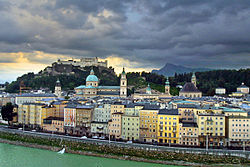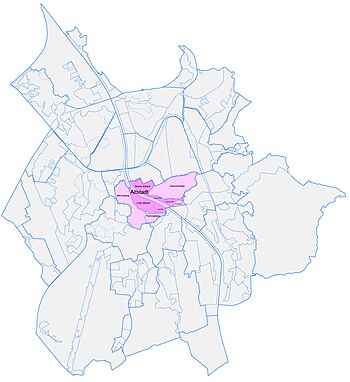Historic center of the city of Salzburg
| Historic center of the city of Salzburg | |
|---|---|
|
UNESCO world heritage |
|

|
|
| View of Salzburg's old town from the Kapuzinerberg |
|
| National territory: |
|
| Type: | Culture |
| Criteria : | ii, iv, vi |
| Surface: | 236 ha |
| Reference No .: | 784 |
| UNESCO region : | Europe and North America |
| History of enrollment | |
| Enrollment: | 1996 (session 20) |
The historic center of the city of Salzburg , English Historic Center of the City of Salzburg , is the city center of the city of Salzburg and one of the UNESCO World Heritage Sites in Austria . It is protected under state law by the Salzburg Old Town Conservation Act and, as the old town of Salzburg or old town, is largely congruent with one of the city districts according to the new city structure.
Scope of the world heritage zone
The world heritage includes:
- the left old town ( left the Salzach )
- the right old town (right of the Salzach) with the Linzer Gasse , the Inner and Outer Stone and the Bürgelstein
- the Inner Nonntal
- the inner garbage
- the Mönchsberg
- the fortress mountain with the fortress Hohensalzburg
- the Kapuzinerberg
This core zone covers 236 hectares . It is almost identical to the Altstadt district (237 hectares ).
The mitausgewiesene buffer zone - which is a restricted ensemble protect and to preserve the core zone before impairment in remote image - extends about the entire Outer Nonntal (Hellbrunnerstraße - Hofheim Allee, including landform Freisaal , and the Thumeggerstraße), the room Leopoldskron lake , the part of Riedenburg-St. Paul , Rainberg , Innere Riedenburg , Ausseres Mülln and Johannesspital (LKH, with line Moosstraße - Aiglhofstraße - railway line towards Munich as the border) and the southeastern block of Lehen (Gaswerkgasse and up to Lehener Brücke ), and on the other side the entire Neustadt , Elisabeth - Suburb to St.-Julien-Straße, train station area , from there Schallmoos to within Vogelweiderstraße - Sterneckstraße - Fürbergstraße, and further Inneres Parsch within Eberhard-Fugger-Straße - Gaisbergstraße, and Hundertwasserallee to Salzach. This buffer zone covers 487 hectares (approx. 5 km²).
Justification and protection status
The old town of Salzburg was on 5 December 1996 by the UNESCO award World Heritage awarded.
This award was given for the following reasons:
“As the spiritual center of Central Europe, the importance of the former prince-archbishop's residence city of Salzburg goes back to the early days of Western culture. The bishop's seat, the oldest continuously existing archbishopric north of the Alps, the cathedral and the monasteries of St. Peter and Nonnberg , which also go back to the Carolingian era and are still alive today, form the core of which the structural development of the historical conception and substance well-preserved city ran out. The archbishops employed important artists of their time through the centuries. A lively intermingling of diverse medieval and baroque monuments comes together in the old town to form a unique urban ensemble dominated by the Hohensalzburg Fortress . Under the impressive silhouette of the towers and domes of the many churches , the closed façade prospects of the town houses line the squares and winding streets to the left and right of the Salzach. The music and festival tradition associated with the Genius Loci Wolfgang Amadeus Mozart is part of the special flair of this unique city monument. "
The following criteria were recognized.
- II: indicates, for a period of time or in a cultural area of the earth, a significant intersection of human values in relation to the development of architecture or technology, large-scale sculpture, urban development or landscape design
- IV: represents an excellent example of a type of building, architectural or technological ensemble or landscape that symbolizes one or more significant periods of human history
- VI: is linked in a direct or recognizable manner with events or traditional ways of life, with ideas or creeds or with artistic or literary works of exceptional universal importance
The unity of the ensemble is emphasized in its development up to the modern age, there are buildings from the Middle Ages to the 20th century, whereby the priority of the historical value of the baroque episcopal city is emphasized, but also the vulnerability of the buildings in the buffer zone .
In addition to the UNESCO protection, the city center is also protected by numerous individual designations as a monument under the Monument Protection Act, and in particular the Salzburg Old Town Conservation Act 1967, the first of its kind in Austria, and since 2007 also the grassland declaration , which the existing open spaces in the core city and in the surrounding area Salzburg Green Belt ) is to protect it from building over the long term. The intensive national and regional protection of the historic old town and the functioning management of urban development are praised by UNESCO. The protective position is monitored by ICOMOS , the international council for the preservation of monuments. Both the Federal Monuments Office and the Federal Monuments Office repeatedly criticize the lack of communication with the building authorities in the city ( design advisory board of the city of Salzburg, expert commission on the Old Town Conservation Act).
See also
literature
- Assessment of the old town before it is announced as a World Heritage Site. (PDF; 1.3 MB) UNESCO World Heritage Center, October 23, 1995, accessed on April 1, 2018 (English).
- Vitruvius: Salzburg must not become Las Vegas. In: malfunctions online, nov / dec. 96. Retrieved January 16, 2013 .
Map:
- Map “UNESCO World Heritage property, Historic Center of the city of Salzburg 1996”, scale 1: 5000. (PDF) In: World Heritage List. UNESCO, 2008, accessed April 1, 2018 .
Web links
- Entry on the UNESCO World Heritage Center website ( English and French ).
- World Heritage Site Salzburg Old Town , City of Salzburg, stadt-salzburg.at → Education & Culture → Old Town & Tourism
Individual evidence
- ↑ A key building of this intention is the controversial central heating power station , actually an urban development problem that was solved by a new building in 2003.
- ^ Translation, quoted from the reasons given by the UNESCO jury. (No longer available online.) City of Salzburg, archived from the original on November 28, 2011 ; Retrieved January 22, 2012 . Info: The archive link was inserted automatically and has not yet been checked. Please check the original and archive link according to the instructions and then remove this notice.
- ↑ “ It contains a number of buildings, both secular and ecclesiastical, of very high quality from periods ranging from the late Middle Ages to the 20th Century. ”UNESCO-WHC: Adoption of retrospective Statements of Outstanding Universal Value , WHC-10 / 34.COM / 8E, Paris, June 18, 2010, entry Property: Historic Center of the City of Salzburg . P. 40 ( pdf )
- ^ " The overall coherence is vulnerable to the adverse impact of new developments in the buffer zone and setting. "WHC-10 / 34.COM / 8E, Authenticity (2010) , p. 40
- ↑ “ The town has generally managed to preserve its historic substance and fabric, although it is vulnerable to new constructions which are not entirely sympathetic to the coherence of its Baroque form. ” WHC-10 / 34.COM / 8E, Integrity (2010) , P. 40
- ↑ REK 2007 declaration 'Geschützes Grünland' , Salzburg stadt-salzburg.at → urban planning
- ↑ “ Management occurs at national, regional and local level. The property is protected at both Federal and Provincial level. A number of other specific laws regarding particular matters (such as water management) also apply. In addition, consensual management is practiced, where property owners and relevant cultural societies can also bring about individual actions. "WHC-10 / 34.COM / 8E, Protection and management requirements (2010) , p. 40
-
↑ about:
Claudia Lagler: World Heritage: Trouble about Salzburg. The organization Icomos, which watches over the world cultural heritage, is alienated by Salzburg's approach: They are not involved in current construction projects. In: Die Presse online, October 21, 2012.
Claudia Lagler: “Unesco angry about Salzburg”. The outgoing state curator Ronald Gobiet criticizes the lack of commitment in Salzburg. In: Die Presse online, December 2, 2012.
Coordinates: 47 ° 48 ' N , 13 ° 3' E



